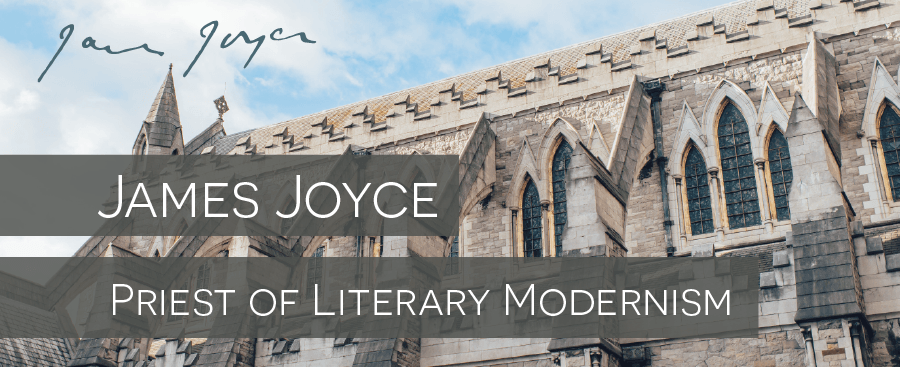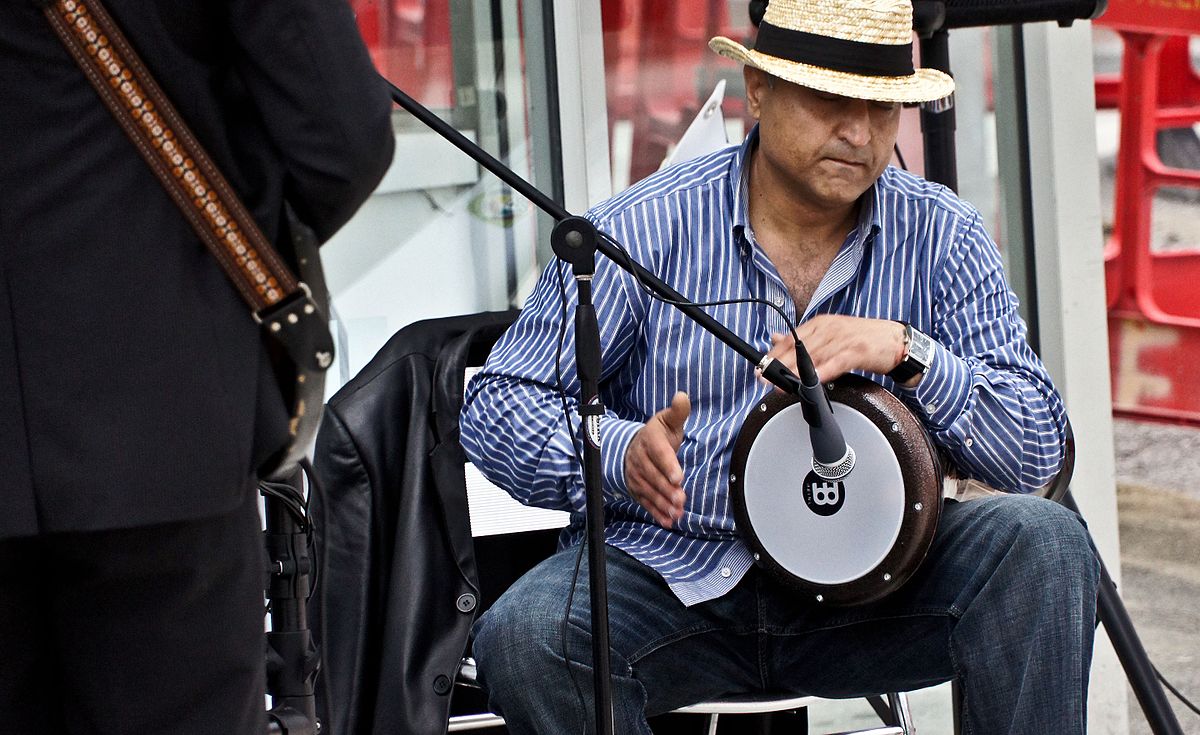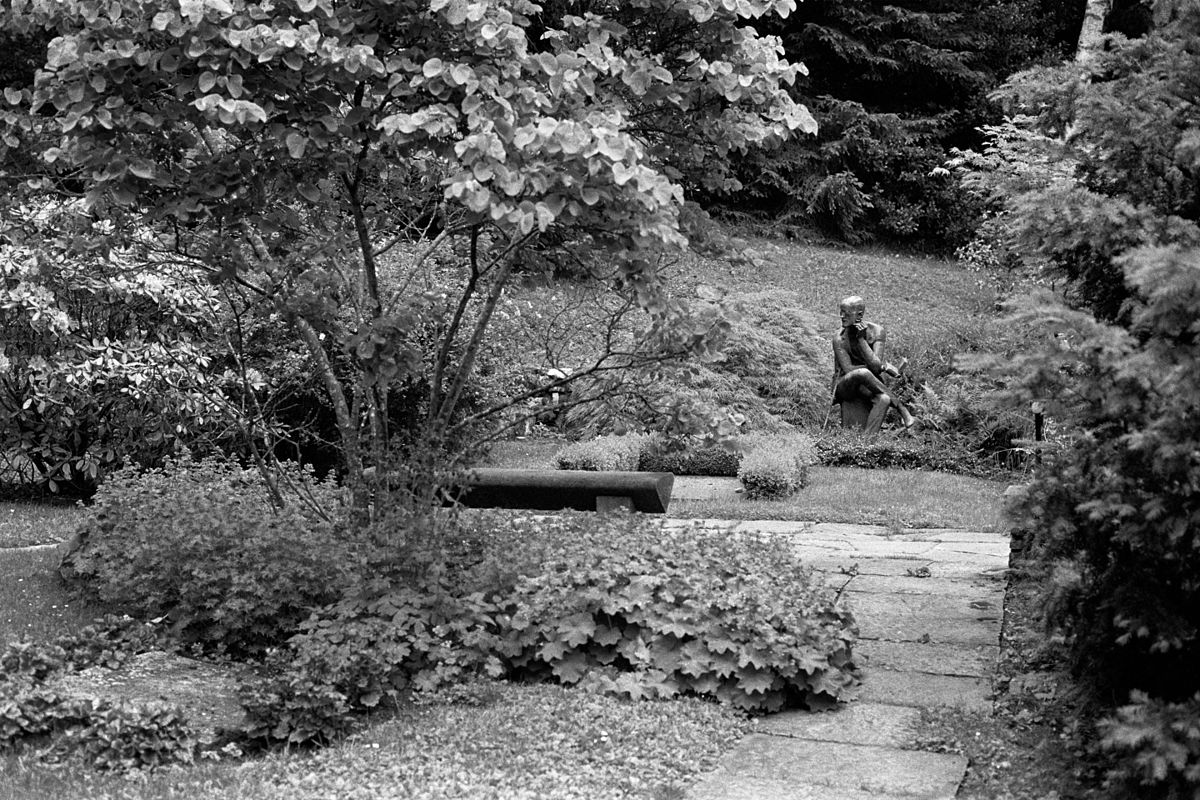James Joyce: Priest Of Literary Modernism

Irish writer James Joyce is a very polarizing figure.
Some people love his wit, his wordplay, and his inventiveness. Other readers simply cannot stand his scholastic allusiveness.
However you may feel about this literary giant, it is impossible to understand 20th century Modernism without him. Along with T.S. Eliot, Ezra Pound, Virginia Woolf, and William Faulkner, Joyce is one of those indispensable writers who defined the voice of an era.
Indeed, if you are willing to undergo the struggle, Joyce’s books offer not only great wisdom but also great fun. Read on for a general overview of Joyce’s life and works so if you choose to pick one of his daunting books off of your local library’s shelves, you’ll be a bit better equipped to match minds with this literary master.
James Joyce biography

James Joyce portrait, via Wikimedia Commons
It is simply impossible to understand what’s going on in Joyce’s works without understanding his life. Perhaps this could be said about any author’s work, but it is especially so with Joyce. Although Joyce never wrote a proper “autobiography,” many important moments in his own life served as the basis for his novels.
Like father, like son
James Joyce was born on February 2, 1882, in what he would later call, “dear dirty Dublin.” His father was John Stanislaus Joyce, and his mother was Marry Murray Joyce. Joyce also had 10 siblings, of whom he was the eldest.
John Stanislaus Joyce, although known for his talented tenor voice, was a heavy drinker. His drinking caused a great deal of distress financially and emotionally for the Joyce household. Later in life, James Joyce himself would discover his own wonderful tenor voice as well as his penchant for drink. The father/son relationship would become central in Joyce’s psyche, and it is at the very heart of his seminal work Ulysses.
Early education
James Joyce proved to be extremely precocious in his schoolwork at an early age. Despite financial hardships, the family was able to send Joyce to Clongowes Wood College and then Belvedere College, two very prestigious Jesuit schools in Ireland. The incidents at these schools form the bulk of Joyce’s novel A Portrait of the Artist as a Young Man.
Joyce was obsessed with religion, language, philosophy, and literature from an early age.
Although many claim he became an atheist later in life, the organization and rigor of Catholic scholasticism is always present in his works. Some of Joyce’s main influences during his prep school days included Dante, St. Thomas Aquinas, Aristotle, Shakespeare, and Ibsen. Indeed, Joyce was so enraptured with the dramas of Ibsen that he forced himself to learn basic Norwegian just so he could write a “fan letter” to the great dramatist.
University and beyond
Joyce later enrolled in University College Dublin in 1898. Here he studied Italian, French, and English, and he received his B.A. in Modern Languages in 1902.
Joyce then went off to Paris ostensibly to attend lectures on medicine. Truth be told, Joyce was never good at medicine. He even flunked his medicine courses in English. When Joyce was not frequenting cafés or brothels, he was spending most of his time in Paris reading literary, theological, and philosophical texts in La Bibliothèque Sainte-Geneviève.
Later that year, Joyce’s mother was diagnosed with cancer. He quickly returned to Ireland to visit his mother. When his mother, who feared her son was losing his faith in God, told Joyce to repent and kneel before her, Joyce refused to kneel. This event became a central trauma in Joyce’s psyche that never left him. It is revisited over and over again throughout Portrait and Ulysses. Joyce’s mother died in 1903.
Nora Barnacle and Bloomsday
Joyce then began drinking very heavily. He remained in Ireland doing various jobs like teaching, singing, and writing articles. Perhaps more important than these first forays into literature, Joyce met Nora Barnacle (1884-1951) at this time. Barnacle was a Dublin hotel worker who was born in Galway.
On June 16th, 1904, a date that has since become known as Bloomsday, Joyce first courted Barnacle. Joyce and Barnacle weren’t officially married until 1931, but they remained close together for the rest of their lives. They eventually had two children together, Georgio and Lucia.
After only a few months acquaintance, Barnacle took off with Joyce to continental Europe and moved wherever Joyce could find work. Joyce would never return to Ireland again. Joyce took up various English teaching posts in cities like Pula, Trieste, Rome, and Paris.

Celebrating Bloomsday in Ireland by William Murphy, via Wikimedia Commons
James Joyce books
It wasn’t until 1914 that Joyce’s first official book was published.
This book, called Dubliners, is a collection of 15 short stories about children, men, and women living in Dublin. Realist authors like Gustave Flaubert heavily influenced Joyce’s stories, but these tales of grim reality in turn-of-the-century Dublin stand on their own. If you’ve never read Joyce before, Dubliners is the best place to start.
Two years later, Joyce finally finished revising Portrait, and it was published very quickly. Portrait is a deeply autobiographical bildungsroman that tells the tale of Stephen Dedalus (aka Joyce) growing up in Ireland.
It was Portrait‘s experimental style that caught the attention of the famous American poet Ezra Pound. Pound later became instrumental in helping Joyce find publishers and integrate into the Modernist literary scene.
Mighty Ulysses
Joyce’s major work, Ulysses, began as a short story for his Dubliners collection in 1914. However, Joyce let this work grow over the years.
He began writing Ulysses in Trieste, but when World War I broke out, he moved to Zürich, Switzerland, to finish the book in relative peace. All the while, Joyce was barely scraping by and living off donations from literary patrons and from Barnacle’s uncle. Once Sylvia Beach published Ulysses in Paris in 1922, Joyce never really had to worry about finances again.
Plot of Ulysses
Ulysses takes place in Dublin on June 16th, 1904, and follows three major characters:
- failed poet Stephen Dedalus
- the Jewish advertisement writer Leopold Bloom
- Bloom’s unfaithful wife Molly
Joyce famously assigned different sections of Homer’s the Odyssey to the various “chapters” in this book. Stephen is a stand-in for Telemachus, Leopold Bloom for Odysseus/Ulysses, and Molly Bloom for Penelope. But it is far more complicated than that.
Joyce works with irony, puns, and allusion after allusion after allusion. To fully appreciate his literary wit, you should be sure to read Hamlet, the Odyssey, and Joyce’s previous novels before embarking on Ulysses. All of them are referenced quite a lot in this difficult, yet somehow enchanting, text. Scholars can, and have, spend years laboring over what every pun and allusion “means” in this epic work of the modern era.
Ulysses enjoyed a great succès de scandale immediately after it was published. Some readers in the UK, Ireland, France, and the USA deemed the work reprehensible, and many governments put bans on publishing the book.
It wasn’t until 1934 when Judge John M. Woolsey declared Ulysses not pornographic, lifting the ban on its publication in the USA. Other nations soon followed suit.
Life Post-Ulysses
Although Joyce was able to live off of the sales of Ulysses, he began to suffer severe eye problems that plagued him for the rest of his life. He went for various treatments in Parisian hospitals, but he suffered spells of blindness for long stretches of time. Some claim his eye problems were due to syphilis.
During this trying time, his daughter, Lucia Joyce (1907-1982), showed increasing signs of mental instability. Lucia worked as a professional dancer for many years, but she started to show signs of mental distress in the 1930s. Eventually, her mental state became so bad that she had to be institutionalized. Doctors believe Lucia suffered from schizophrenia, and this disease had a tremendous impact on Joyce’s life and later texts.
Finnegan’s Wake
Many believe that these struggles in Joyce’s later life help explain his famously difficult and strange final novel Finnegan’s Wake, published in 1939.
Although most readers couldn’t make heads or tails of this book, it sold quite well and enjoyed critical acclaim. Some described Finnegan’s Wake as a dream, while others see it as a poetic expression of Nietzsche’s idea of the “eternal return.” Some see it as prophetic of our own electronic age, and still others see the Wake as a deep meditation on Giambattista Vico’s conception of history.
Whatever it may be, Finnegan’s Wake is certainly one of the most exhilarating and bewildering novels of all time. If you want to explore this work, be sure to keep a good reference by your side.
When World War II broke out, Joyce moved with his family back to Zürich. Joyce passed away on January 13, 1941, after intestinal surgery. He was buried in Fluntern cemetery in Zürich. Joyce was 59 years old.

James Joyce’s grave in Zurich, Switzerland, by Nicholas Hartmann, via Wikimedia Commons
James Joyce poems and drama
Ireland arguably produced three of the greatest writers in poetry, drama, and prose in the 20th century:
- W.B. Yeats as the poet
- Samuel Beckett (who was quite close to James Joyce) as the master dramatist
- James Joyce as writer of prose
Although Joyce focused on prose, he did write a couple of poetry books as well as one play. His most famous book of poetry is called Chamber Music, which he published in 1907. Most of Joyce’s poems are sharp jabs against the Celtic Revival that was going on in Ireland at the time.
Joyce’s only play, The Exiles, was published in 1918. It is mainly read today as a forerunner of the themes of marital infidelity he would explore in Ulysses.
James Joyce Irish pub

Davy Byrne’s Irish pub in Dublin, Ireland, by DanMS, via Wikimedia Commons
Joyce’s legacy is still celebrated in Dublin. One of the major tourist traps for Joyce fans is Davy Byrne’s pub, which Joyce referenced in both Dubliners and Ulysses.
Joyce certainly had a strained relationship with Dublin, and Ireland had a very strained relationship with him for years. Nowadays, however, anyone who has read Ulysses cannot help seeing the city through Joyce’s eyes.
James Joyce: priest of Modernity
Although Joyce certainly rejected the Catholic Church in his life, he admired the process of transubstantiation, or making everyday bread and wine into the transcendent substances of the Godhead.
Perhaps it is fitting to conclude this little look into Joyce’s life with a famous letter he wrote to his brother Stanislaus. This short paragraph is good to keep in mind when trying to understand just what the heck Joyce was trying to do in his work:
“Don’t you think there is a certain resemblance between the mystery of the Mass and what I am trying to do? I mean that I am trying … to give people some kind of intellectual pleasure of spiritual enjoyment by converting the bread of everyday life into something that has a permanent artistic life of its own … for their mental, moral, and spiritual uplift.”






Leave a Reply
Be the First to Comment!